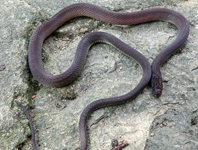Abstract
Three new species of the genus Longior Travassos & Kloss, 1958 are described and illustrated, namely L. surieli n. sp. in Antillanax dominicanus (Doesburg, 1953) from the Dominican Republic, L. lamothei n. sp. in Passalus punctiger Le Peletier & Serville, 1825 from Mexico and Colombia and L. zumpimito n. sp. in P. punctatostriatus Percheron, 1835 from Mexico. These constitute the first records of the genus Longior for the aforementioned countries, rising to nine species in the genus. The new species can be differentiated mainly by the length of their body, oesophagus and tail in both sexes, the extension of the lateral alae in the females and the morphology of the cephalic and posterior end in the males. The molecular phylogeny of the new taxa is inferred by the 28S and 18S rDNA and they form a monophyletic clade with other Longior species. The phylogeny of Longior and that of their passalid hosts reveal coevolutionary relationships. These patterns suggest that the phylogeny of Longior species is probably strongly influenced by the evolutionary trajectories of their passalid hosts.
References
Adamson, M.L. & Van Waerebeke, D. (1992) Revision of the Thelastomatoidea, Oxyurida of invertebrate hosts III. Hystrignathidae. Systematic Parasitology, 22, 111–130.
https://doi.org/10.1007/BF00009604
Blaxter, M.L., De Ley, P., Garey, J.R., Liu, L.X., Scheldeman, P., Vierstraete, A., Vanfleteren, J.R., Mackey, L.Y., Dorris, M., Frisse, L.M., Vida, J.T. & Thomas, W.K. (1998) A molecular evolutionary framework for the phylum Nematoda. Nature, 392, 71–75.
Capella-Gutiérrez, S., Silla-Martínez, J.M. & Gabaldón, T. (2009) trimAl: a tool for automated alignment trimming in large-scale phylogenetic analyses. Bioinformatics, 25, 1972–1973.
https://doi.org/10.1093/bioinformatics/btp348
Edgar, R.C. (2004) MUSCLE: multiple sequence alignment with high accuracy and high throughput. Nucleic Acids Research, 32, 1792–1797.
https://doi.org/10.1093/nar/gkh340
García, N., Ventosa, L. & Morffe, J. (2009) Dos especies nuevas de los géneros Lepidonema y Longior (Thelastomatoidea: Hystrignathidae) de la Isla de la Juventud, Cuba. Solenodon, 8, 1–7.
Hunt, D.J. (1981) On Artigasia horridospina n.sp., Longior semialata n.sp., Mentecle magnifica n.sp., Paraxyo ensicrinatus n.sp. (Oxyurida: Hystrignathidae) and Pulchrocephala? pulchrocephala Travassos, 1925 (Oxyurida: Pulchrocephalidae). Systematic Parasitology, 3, 33–52.
https://doi.org/10.1007/BF00012238
Jiménez-Ferbans, L., González, D. & Reyes-Castillo, P. (2016) Phylogeny and species delimitation in the group Rhodocanthopus of the genus Passalus (Coleoptera: Passalidae) inferred from morphological and molecular data, with description of two new species. Arthropod Systematics & Phylogeny, 74, 255–266.
Morffe, J. & García, N. (2011a) Coynema gen. n., a new genus of nematode (Thelastomatoidea, Hystrignathidae) parasites of Passalidae (Coleoptera) from Cuba. ZooKeys, 75, 9–19.
https://doi.org/10.3897/zookeys.75.809
Morffe, J. & García, N. (2011b) On some Cuban species of the genus Longior Travassos & Kloss, 1958 (Oxyurida, Hystrignathidae), with description of a new species. ZooKeys, 78, 1–14.
https://doi.org/10.3897/zookeys.78.958
Morffe, J. & García, N. (2012) Una especie nueva de Longior Travassos et Kloss, 1958 (Oxyurida: Hystrignathidae) parásita de un pasálido (Coleoptera: Passalidae) de Panamá. Novitates Caribaea, 5, 73–80.
https://doi.org/10.33800/nc.v0i5.127
Morffe, J. & García, N. (2013) Batwanema gen. n. and Chokwenema gen. n. (Oxyurida, Hystrignathidae), new nematode genera as parasites of Passalidae (Coleoptera) from the Democratic Republic of Congo. ZooKeys, 361, 1–13.
https://doi.org/10.3897/zookeys.361.6351
Morffe, J., García, N., Breugelmans, K. & Adams, B.J. (2018) Morphological examination and phylogenetic analysis clarify the taxonomic status of Cuban Longior Travassos & Kloss, 1958 (Nematoda: Thelastomatoidea: Hystrignathidae). Zootaxa, 4399 (4), 521–542.
https://doi.org/10.11646/zootaxa.4399.4.3
Morffe, J., García, N. & Ventosa, L. (2009) Longior similis sp. nov. (Thelastomatoidea: Hystrignathidae) parasite of Passalus interstitialis from western Cuba and new records of Longior zayasi. Solenodon, 8, 12–19.
Nadler, S.A., De Ley, P., Mundo-Ocampo, M., Smythe, A.B., Stock, S.P., Bumbarger, D., Adams, B.J., De Ley, I.T., Holovachov, O. & Baldwin, J.G. (2006) Phylogeny of Cephalobina (Nematoda): molecular evidence for recurrent evolution of probolae and incongruence with traditional classifications. Molecular Phylogenetics and Evolution, 40, 696–711.
https://doi.org/10.1016/j.ympev.2006.04.005
Rambaut, A., Suchard, M.A., Xie, W. & Drummond, A.J. (2003) Tracer. Version 1.6. Available from: http://beast.bio.ed.ac.uk/Tracer (accessed 12 October 2016)
Ronquist, F., Teslenko, M., van der Mark, P., Ayres, D.L., Aaron, D., Höhna, S., Larget, B., Liu, L., Suchard, M.A. & Huelsenbeck, J.P. (2012) MrBayes 3.2: efficient Bayesian phylogenetic inference and model choice across a large model space. Systematic Biology, 61, 539–542.
https://doi.org/10.1093/sysbio/sys029
Seinhorst, J.W. (1959) A rapid method for the transfer of nematodes from fixative to anhydrous glycerin. Nematologica, 4, 67–69.
https://doi.org/10.1163/187529259X00381
Spiridonov, S.E. & Guzeeva, E.A. (2009) Phylogeny of nematodes of the superfamily Thelastomatoidea (Oxyurida) inferred from LSU rDNA sequence. Russian Journal of Nematology, 17, 127–134.
Tamura, K., Stecher, G., Peterson, D., Filipski, A. & Kumar, S. (2013) MEGA6: Molecular Evolutionary Genetics Analysis version 6.0. Molecular Biology and Evolution, 30, 2725–2729.
https://doi.org/10.1093/molbev/mst197
Travassos, L. & Kloss, G.R. (1958) Sobre a fauna de nematodeos dos coleopteros Passalidae da Estaçao Biologica de Boracéia. Arquivos de Zoologia, Sao Paulo, 11, 23–57.


